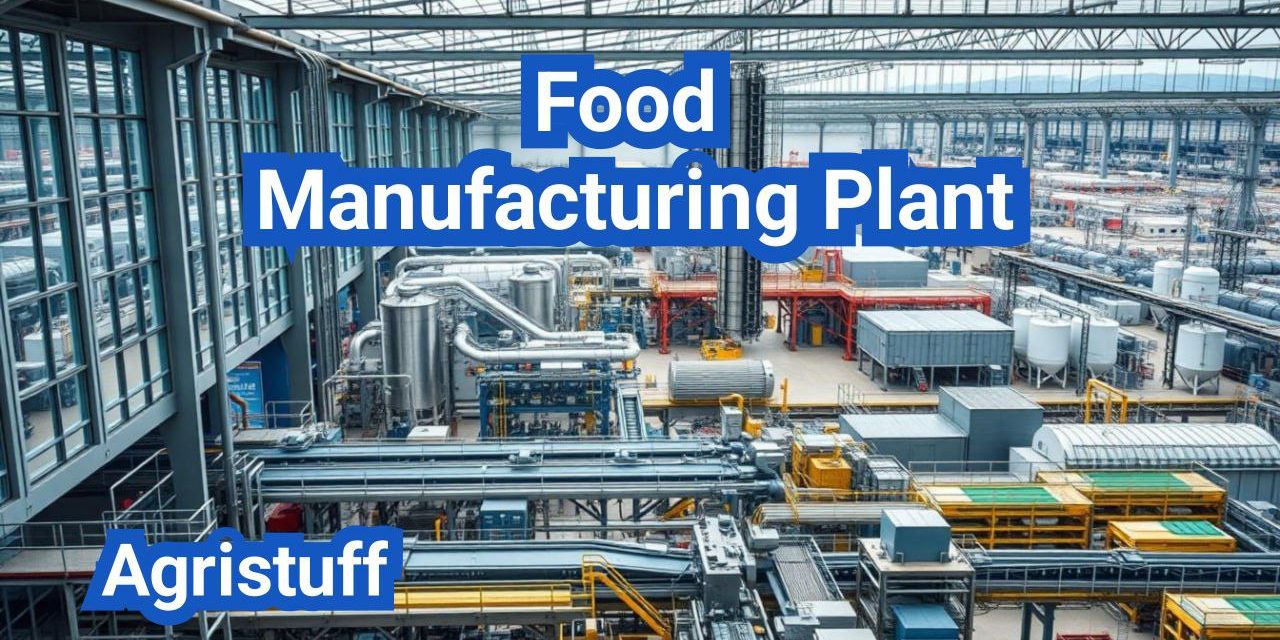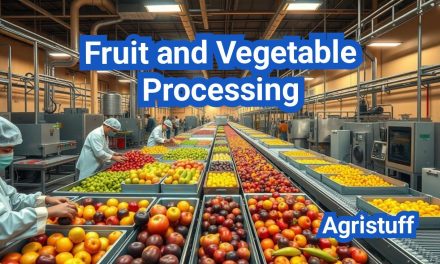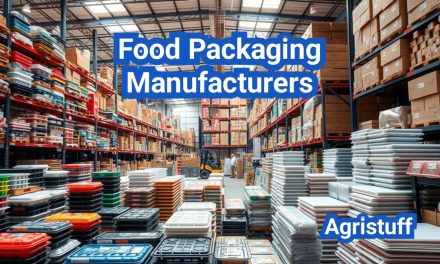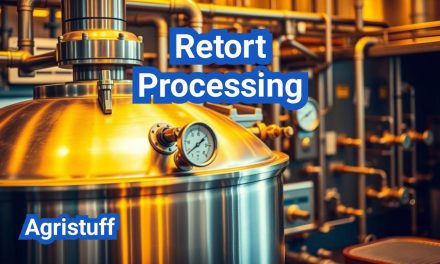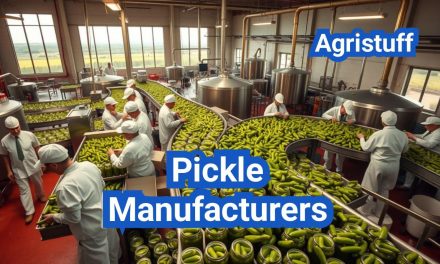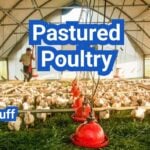Designing a food processing facility in the United States requires meticulous planning to ensure compliance with U.S. regulations and industry standards.
The layout of a food manufacturing facility is critical for maintaining a clean and safe environment. It involves segregating areas for different processes and ensuring that the facility is designed for sustainability.
Setting up a compliant food manufacturing operation in the USA involves understanding the regulatory requirements and industry best practices. This includes considerations for utilities, sanitation, and employee safety.
Key Takeaways
- Understanding the importance of facility layout in food processing.
- Compliance with U.S. regulations and industry standards.
- The role of utilities in maintaining a safe and clean environment.
- Best practices for sustainability in food manufacturing.
- Segregation of areas to prevent cross-contamination.
The Evolution of Food Manufacturing in the United States
The evolution of food manufacturing in the United States reflects broader trends in consumer demand, technological innovation, and regulatory compliance. Over the years, the industry has adapted to changing consumer preferences, incorporated advanced technologies, and complied with increasingly stringent regulations.
Current State of the Food Processing Industry
The current state of the food processing industry is characterized by a focus on automation, sustainability, and employee amenities. Modern food manufacturing companies are investing heavily in automation technologies to enhance efficiency and reduce labor costs. Sustainability has also become a key consideration, with many companies adopting environmentally friendly practices and sourcing ingredients from sustainable suppliers.
Some notable examples of food manufacturing companies that have made significant strides in these areas include General Mills, PepsiCo, and Tyson Foods. These companies have implemented various initiatives aimed at reducing their environmental footprint and improving working conditions for their employees.
Major Categories of Food Manufacturers
Food manufacturers in the United States can be broadly categorized into several major groups based on the types of products they produce. These categories include:
- Dairy products manufacturers
- Meat, poultry, and seafood processors
- Fruit and vegetable processors
- Grain mill and bakery product manufacturers
- Other food manufacturers (including confectionery, snack foods, and beverages)
| Category | Examples of Products | Notable Companies |
|---|---|---|
| Dairy Products | Milk, cheese, yogurt | Dairy Farmers of America, Nestle |
| Meat, Poultry, and Seafood | Beef, chicken, salmon | Tyson Foods, Perdue Farms, Cargill |
| Fruit and Vegetable | Canned goods, frozen produce | Del Monte, General Mills |
Regional Distribution and Economic Impact
The food manufacturing industry is not evenly distributed across the United States; certain regions are more conducive to specific types of food production due to factors like climate, access to raw materials, and transportation infrastructure. The industry has a significant economic impact, providing employment opportunities and contributing to local economies.
Key regions for food manufacturing include the Midwest, known for its agricultural production and meatpacking industries, and California, which is a major producer of fruits and vegetables. The economic impact of the industry is substantial, with food manufacturing companies generating billions of dollars in revenue each year.
Regional Highlights:
- Midwest: Known for agricultural production and meatpacking
- California: Major producer of fruits and vegetables
- Northeast: Significant dairy production
Key Components of a Food Manufacturing Plant

Food manufacturing plants are intricate systems that involve multiple components working in harmony to produce safe and quality food products. The efficiency and compliance of these plants depend on several critical elements.
Production and Processing Areas
The production and processing areas are the heart of any food manufacturing plant. These spaces are where raw materials are transformed into finished products. Efficient layout and design of these areas are crucial to ensure smooth operations and maintain high standards of quality and safety.
According to industry experts, “The layout of production and processing areas significantly impacts the overall efficiency and productivity of a food manufacturing plant.”
“A well-designed production area can reduce production time by up to 30% and improve product quality by minimizing cross-contamination risks.”
Storage and Warehousing Facilities
Storage and warehousing facilities play a vital role in food manufacturing plants. These areas are used to store raw materials, work-in-progress, and finished goods. Proper storage conditions are essential to maintain product quality and prevent contamination.
- Raw material storage areas should be designed to prevent pest infestation and contamination.
- Finished goods storage areas should maintain appropriate temperature and humidity levels.
- Warehousing facilities should be equipped with adequate shelving and inventory management systems.
Support and Administrative Spaces
Support and administrative spaces are also crucial components of a food manufacturing plant. These areas include offices, laboratories, and employee facilities. Adequate administrative spaces are necessary for managing day-to-day operations, quality control, and regulatory compliance.
For instance, laboratories are essential for conducting quality control tests and ensuring compliance with food safety regulations. Employee facilities, such as cafeterias and locker rooms, contribute to a positive working environment.
Strategic Site Selection for Food Processing Facilities
The strategic selection of a site for a food processing facility is crucial for ensuring logistical efficiency, regulatory compliance, and long-term operational success. Food manufacturing companies in the USA must consider various factors to optimize their operations.
Geographic and Logistical Considerations
Geographic location plays a significant role in the success of a food processing plant. Proximity to raw materials, transportation hubs, and consumer markets can significantly reduce costs and enhance efficiency. For instance, a facility located near agricultural production areas can minimize transportation costs and ensure fresher ingredients.
Key logistical considerations include:
- Access to major highways and transportation infrastructure
- Proximity to ports for international trade
- Availability of skilled labor in the region
As noted by industry experts, “The location of a food processing plant can significantly impact its bottom line through reduced transportation costs and improved supply chain efficiency.”
“A well-chosen location can be a game-changer for food processing companies, enabling them to respond quickly to market demands and maintain a competitive edge.”
— Food Processing Magazine
Utility Access and Infrastructure Requirements
A reliable supply of utilities such as water, electricity, and gas is essential for food processing operations. The availability and cost of these utilities can vary significantly by location.
| Utility | Considerations | Impact on Operations |
|---|---|---|
| Water | Quality and quantity | Processing and cleaning operations |
| Electricity | Reliability and cost | Powering equipment and facilities |
| Gas | Supply chain and pricing | Cooking, heating, and processing |
Regulatory Environment and Zoning Factors
Understanding the regulatory environment and zoning laws is critical when selecting a site for a food processing facility. Compliance with local, state, and federal regulations can impact the feasibility and cost of establishing and operating a plant.
Regulatory considerations include environmental regulations, health and safety standards, and zoning restrictions. Ensuring compliance with these regulations from the outset can prevent costly modifications or legal issues down the line.
By carefully evaluating these factors, food processing companies can select a site that supports their operational needs, ensures compliance with regulatory requirements, and positions them for long-term success in the competitive food manufacturing industry.
Designing an Optimal Food Manufacturing Plant Layout

Creating an optimal layout for a food manufacturing plant involves careful planning to optimize process flow, prevent cross-contamination, and allow for future expansion. An effective layout is crucial for maintaining high standards of food safety, quality, and operational efficiency.
Process Flow Optimization Principles
Process flow optimization is critical in a food manufacturing plant to ensure efficient production and minimize the risk of contamination. This involves designing the layout to facilitate a smooth workflow from raw material intake to finished product packaging.
- Implementing a linear production flow to reduce backtracking and crossovers
- Strategically locating processing equipment to minimize movement and maximize productivity
- Ensuring adequate space for personnel and equipment maintenance
Optimizing process flow not only enhances efficiency but also reduces the risk of contamination by minimizing the movement of personnel and materials.
Cross-Contamination Prevention Strategies
Preventing cross-contamination is paramount in food manufacturing. The plant layout should be designed to segregate different production areas and implement effective cleaning and sanitation protocols.
Key strategies include:
- Segregating raw material storage from finished goods and production areas
- Implementing zoning to control airflow and prevent the spread of contaminants
- Designating separate areas for allergen processing to prevent cross-contact
Future Expansion Planning
Planning for future expansion is essential when designing a food manufacturing plant layout. This involves anticipating potential growth and ensuring that the current layout can accommodate increased production demands.
| Expansion Considerations | Design Strategies |
|---|---|
| Increased Production Capacity | Modular design to facilitate easy expansion of production lines |
| New Product Lines | Flexible layout to accommodate different production requirements |
| Regulatory Compliance | Designing with future regulatory changes in mind |
By incorporating these elements, a food manufacturing plant can ensure a layout that is not only efficient and safe but also adaptable to future needs.
Food Plant Design: Structural and Material Considerations
Effective food manufacturing operations depend on a well-designed plant that meets stringent food safety standards. The design of a food manufacturing plant involves critical considerations to ensure the production of safe and quality food products.
Flooring Systems and Drainage Requirements
The flooring system in a food processing plant is a crucial element that requires careful consideration. It must be durable, slip-resistant, and easy to clean. Common materials used for flooring include epoxy, polyurethane, and concrete with various coatings. Adequate drainage is also essential to prevent water accumulation, which can lead to contamination.
Key Considerations for Flooring Systems:
- Durability and resistance to chemicals and heavy foot traffic
- Smooth, even surfaces to facilitate cleaning
- Slip-resistance to prevent accidents
- Adequate drainage to prevent water accumulation
Wall and Ceiling Construction Standards
Walls and ceilings in a food processing plant must be constructed to prevent contamination and ensure ease of cleaning. Materials used should be non-toxic, durable, and resistant to moisture. Gypsum board, stainless steel, and fiberglass-reinforced plastic are common materials used.
| Material | Characteristics | Application |
|---|---|---|
| Gypsum Board | Cost-effective, easy to install | General construction, non-wet areas |
| Stainless Steel | Durable, resistant to corrosion | High-moisture areas, around equipment |
| FRP (Fiberglass-Reinforced Plastic) | Chemical resistance, easy to clean | Wet areas, around processing equipment |
Hygienic Design Elements for Food Safety
Hygienic design is critical in food processing plants to prevent contamination. This includes designing equipment and facilities that are easy to clean and maintain. Features such as smooth surfaces, rounded corners, and minimal crevices help reduce the risk of bacterial growth.
Best Practices for Hygienic Design:
- Use of materials that are durable and resistant to corrosion
- Designing equipment with easy-to-clean surfaces and minimal crevices
- Implementation of effective cleaning and sanitation protocols
Essential Utility Systems in Food Plant Operations

In the food manufacturing sector, utility systems are the backbone of plant operations. These systems are crucial for maintaining the efficiency, productivity, and compliance of food processing facilities.
Water Supply and Treatment Systems
Water is a critical component in food manufacturing, used for processing, cleaning, and cooling. Therefore, a reliable water supply and treatment system is essential. This involves sourcing water from municipal supplies or wells and treating it to meet the required quality standards for food production.
- Water treatment processes include filtration, disinfection, and sometimes reverse osmosis to remove contaminants.
- Regular testing and maintenance of water treatment systems are necessary to ensure compliance with food safety regulations.
Electrical Infrastructure and Power Requirements
A stable and sufficient electrical supply is vital for the operation of food processing equipment. This includes not only the main power supply but also backup systems such as generators or UPS units to prevent production downtime during power outages.
- Electrical infrastructure should be designed to meet the specific needs of the food processing equipment.
- Regular maintenance of electrical systems is crucial to prevent failures and ensure continuous operation.
Waste Management and Disposal Solutions
Effective waste management is critical in food manufacturing to maintain a clean and safe production environment. This involves implementing systems for the segregation, storage, and disposal of waste.
- Waste management strategies include recycling programs for packaging materials and waste reduction initiatives.
- Proper disposal of waste is essential to comply with environmental regulations and prevent environmental pollution.
By focusing on these essential utility systems, food manufacturing plants can ensure efficient operations, maintain compliance with regulations, and produce safe and high-quality products.
HVAC and Air Handling for Food Manufacturing Environments

In the food manufacturing sector, HVAC systems are not just about comfort; they are critical for maintaining hygiene and product integrity. Effective air handling and HVAC systems are essential for controlling temperature, humidity, and air quality within food processing facilities.
Temperature and Humidity Control Systems
Temperature and humidity control are critical in food manufacturing environments to prevent contamination and ensure product quality. HVAC systems designed for food plants must maintain precise temperature control, often within specific ranges depending on the product being manufactured.
For instance, dairy processing requires cooler temperatures, while baking facilities need higher temperatures. Humidity control is equally important, as excessive moisture can lead to mold growth and product spoilage.
- Maintaining optimal temperature ranges for different food products
- Controlling humidity levels to prevent moisture-related issues
- Implementing advanced HVAC controls for precise environment management
Air Filtration and Positive Pressure Zoning
Air filtration is a crucial aspect of HVAC systems in food manufacturing plants. High-efficiency particulate air (HEPA) filters are often used to remove contaminants from the air, ensuring a clean environment for food processing.
Positive pressure zoning is another important strategy, where certain areas of the facility are maintained at a higher air pressure than others to prevent the ingress of contaminated air. This is particularly important in areas where ready-to-eat foods are processed.
| Area | Air Filtration Requirement | Pressure Zoning |
|---|---|---|
| Raw Material Storage | Standard Filtration | Negative Pressure |
| Food Processing | HEPA Filtration | Positive Pressure |
| Packaging | HEPA Filtration | Positive Pressure |
Energy Efficiency and Sustainability Measures
Energy efficiency is a significant concern for food manufacturing facilities, as HVAC systems can account for a substantial portion of energy consumption. Implementing energy-efficient HVAC solutions not only reduces operational costs but also contributes to sustainability goals.
Measures such as using energy recovery systems, optimizing HVAC system design, and incorporating renewable energy sources can significantly enhance energy efficiency.
- Conducting energy audits to identify optimization opportunities
- Implementing energy recovery ventilation systems
- Utilizing advanced HVAC controls and automation
By focusing on these aspects, food manufacturing facilities can ensure a controlled environment that enhances product quality and safety while minimizing environmental impact.
Culinary Steam and Compressed Air Quality Standards

In the food processing industry, the quality of culinary steam and compressed air plays a significant role in ensuring product safety and regulatory compliance. Food manufacturing plants must adhere to stringent standards to prevent contamination and maintain operational integrity.
Culinary Steam Generation and Distribution
Culinary steam is used directly in food processing and must be generated and distributed in a way that prevents contamination. Boiler treatment chemicals must be food-grade to ensure safety. The distribution system should be designed to prevent backflow and ensure that steam quality is maintained throughout the process.
The generation of culinary steam involves using boilers that are specifically designed for food processing. These boilers must be maintained regularly to prevent the buildup of contaminants. Regular water treatment is also crucial to prevent scaling and corrosion.
Compressed Air Systems for Food Production
Compressed air is used in various aspects of food production, including pneumatic conveying and packaging. The quality of compressed air is critical, as it can come into contact with food products. Compressed air systems must be designed with filters and dryers to remove moisture and contaminants.
The use of oil-free compressors is recommended to prevent oil contamination in the compressed air system. Regular maintenance of compressors and associated equipment is essential to ensure the quality of compressed air.
Monitoring and Maintenance Protocols
Regular monitoring and maintenance are crucial to ensure that culinary steam and compressed air systems operate within required standards. This includes routine inspections of boilers, compressors, and distribution systems.
Maintenance protocols should be documented and followed rigorously to prevent equipment failure and ensure compliance with regulatory requirements. Training personnel on the importance of these protocols is also vital.
By implementing these measures, food manufacturing plants can ensure the quality and safety of their products, maintaining compliance with industry standards.
Refrigeration Systems and Cold Chain Infrastructure

Refrigeration systems play a crucial role in maintaining the integrity of food products throughout the supply chain. In food manufacturing plants, the reliability of these systems is paramount to prevent spoilage and contamination.
Ammonia Refrigeration Safety Protocols
Ammonia refrigeration systems are widely used in food processing facilities due to their efficiency and cost-effectiveness. However, they pose significant safety risks if not properly managed. Implementing safety protocols is crucial to mitigate these risks.
Key safety measures include regular maintenance of equipment, training personnel on ammonia handling, and having emergency response plans in place. Facilities must also comply with regulatory standards set by OSHA and other relevant authorities.
Best practices for ammonia refrigeration safety include:
- Regular inspections and maintenance of ammonia systems
- Training programs for operators and maintenance personnel
- Implementation of emergency shutdown procedures
- Compliance with OSHA regulations and industry standards
Risk Management Program (RMP) Implementation
A Risk Management Program (RMP) is essential for facilities using ammonia refrigeration systems. The RMP helps identify potential hazards, assess risks, and implement strategies to mitigate these risks.
The RMP must include a detailed analysis of the ammonia refrigeration system, including its design, operation, and maintenance. It should also outline emergency procedures and provide training to personnel on RMP protocols.
Process Safety Management (PSM) Compliance
Process Safety Management (PSM) is a regulatory requirement for facilities handling hazardous chemicals, including ammonia. PSM compliance involves implementing a comprehensive management system to prevent and mitigate chemical releases.
Key elements of PSM compliance include process hazard analysis, operating procedures, training programs, and mechanical integrity measures. Facilities must also maintain detailed records and conduct regular audits to ensure compliance.
By implementing robust refrigeration systems, adhering to ammonia refrigeration safety protocols, and complying with RMP and PSM regulations, food manufacturing plants can ensure a safe and efficient operation.
FDA cGMP Compliance for Food Manufacturing Plants

The foundation of a successful food manufacturing operation lies in its ability to comply with FDA cGMP, ensuring a safe and sanitary environment for food production. FDA cGMP regulations provide a framework for food manufacturing plants to follow, guaranteeing the production of safe and wholesome food products.
Personnel Requirements and Training Programs
One of the critical components of FDA cGMP compliance is the training and qualification of personnel involved in food manufacturing. Employees must be trained in the principles of food safety and sanitation, as well as in the specific procedures relevant to their job functions. Effective training programs are essential to prevent contamination and ensure that products are manufactured in a controlled environment.
Training programs should be comprehensive, covering topics such as hygiene practices, equipment operation, and emergency procedures. Regular assessments and updates to training programs are necessary to maintain compliance and adapt to any changes in operations or regulations.
Facility and Equipment Standards
Facility and equipment standards are another vital aspect of FDA cGMP compliance. Food manufacturing plants must be designed and maintained to prevent contamination and ensure easy cleaning and sanitation. This includes having appropriate flooring, wall, and ceiling constructions that meet hygienic design principles.
Equipment used in food processing must be designed for easy cleaning and maintenance, with surfaces that are resistant to corrosion and wear. Regular maintenance and calibration of equipment are crucial to ensure that it operates within specified parameters, thereby maintaining product quality and safety.
Process Controls and Documentation
Process controls are fundamental to ensuring that food products are manufactured consistently and safely. This involves implementing controls at various stages of production, from raw material receipt to finished product storage. Documentation plays a critical role in FDA cGMP compliance, as it provides evidence that processes are being followed and that products meet required standards.
Accurate and detailed records must be maintained for all aspects of food manufacturing, including production, cleaning, and maintenance activities. These records serve as a critical component of a food manufacturer’s ability to demonstrate compliance with FDA cGMP regulations during inspections.
USDA FSIS Facility Requirements and Compliance

Food manufacturing plants must adhere to USDA FSIS regulations to maintain operational integrity and product safety. The USDA FSIS sets specific requirements for facilities involved in meat, poultry, and egg products, focusing on inspection areas, sanitation standards, and product flow segregation to prevent contamination.
Inspection Areas and Official Facilities
The USDA FSIS mandates that food manufacturing plants have designated inspection areas. These areas are critical for ensuring that products meet the required safety and quality standards. Official facilities must be designed to accommodate inspectors and inspection activities without compromising the production process.
Inspection areas should be equipped with necessary amenities and should be strategically located to minimize disruptions to the production flow. The design and layout of these areas are subject to USDA FSIS approval to ensure compliance with regulatory standards.
Operational Sanitation Standards
Operational sanitation is a cornerstone of USDA FSIS compliance. Food manufacturing plants are required to maintain high standards of cleanliness to prevent contamination. This includes implementing effective sanitation standard operating procedures (SSOPs) that cover all aspects of production, from raw material handling to finished product storage.
Regular cleaning schedules, proper waste disposal, and pest control measures are essential components of operational sanitation. Facilities must also maintain detailed records of their sanitation practices to demonstrate compliance during USDA FSIS inspections.
Product Flow and Segregation Requirements
To prevent cross-contamination, food manufacturing plants must implement effective product flow and segregation strategies. This involves designing the production layout to ensure a logical flow from raw materials to finished products, with adequate segregation of different product categories.
Product segregation is particularly important in facilities that handle multiple products or product types. By separating raw and cooked products, and ensuring that products are processed in a manner that prevents re-contamination, facilities can significantly reduce the risk of product contamination.
Effective product flow and segregation not only enhance compliance with USDA FSIS regulations but also contribute to overall operational efficiency and product quality.
Implementing FSMA Preventive Controls in Production

FSMA preventive controls represent a proactive approach to food safety, requiring manufacturers to identify and mitigate potential hazards in their production processes. The implementation of these controls is crucial for ensuring compliance with FSMA regulations and enhancing overall product safety.
Hazard Analysis and Risk Assessment
The first step in implementing FSMA preventive controls is conducting a thorough hazard analysis and risk assessment. This involves identifying potential biological, chemical, and physical hazards associated with the production process. Manufacturers must assess the likelihood and potential impact of these hazards to determine the necessary preventive controls.
A comprehensive hazard analysis should consider various factors, including the type of food being produced, the production environment, and the equipment used. This analysis helps in identifying critical control points where preventive controls can be applied effectively.
| Hazard Type | Description | Preventive Control Measures |
|---|---|---|
| Biological | Presence of harmful microorganisms | Sanitation procedures, temperature control |
| Chemical | Contamination from cleaning agents or pesticides | Proper labeling and storage, segregation of chemicals |
| Physical | Presence of foreign objects like metal or glass | Metal detectors, regular equipment maintenance |
Preventive Controls Implementation
Once the hazards are identified, the next step is to implement preventive controls. These controls are measures designed to prevent or minimize the occurrence of hazards. Examples include sanitation procedures, temperature control, and allergen management protocols.
The implementation of preventive controls requires a thorough understanding of the production process and the potential hazards associated with it. Manufacturers must develop and implement procedures that are tailored to their specific production environment.
Verification and Validation Procedures
After implementing preventive controls, manufacturers must verify and validate their effectiveness. Verification involves checking that the controls are being implemented as planned, while validation ensures that the controls are achieving their intended purpose.
Regular verification and validation activities are essential for maintaining compliance with FSMA regulations and ensuring the ongoing safety of the products. This includes monitoring, record-keeping, and periodic review of the preventive controls.
Food Allergen Control Program Development
The implementation of a comprehensive food allergen control program is a critical step in safeguarding consumer health and regulatory compliance. Food manufacturing plants must adopt a multi-faceted approach to manage allergens effectively.
Allergen Mapping and Production Scheduling
Allergen mapping is a crucial component of food allergen control, involving the identification and documentation of allergenic ingredients throughout the production process. By creating detailed maps of allergen presence, manufacturers can better plan production schedules to minimize cross-contamination risks. Effective production scheduling ensures that products containing major allergens are produced in dedicated lines or at separate times, reducing the likelihood of allergen transfer to non-allergenic products.
To achieve this, food manufacturers should implement robust inventory management systems that track allergenic ingredients and products containing these allergens. This allows for precise control over the production flow and facilitates the segregation of allergenic and non-allergenic products.
Cleaning Validation for Allergen Management
Cleaning validation is a critical aspect of allergen management, ensuring that equipment and production surfaces are thoroughly cleaned to remove allergenic residues. Validation protocols should be established to verify the effectiveness of cleaning procedures, using techniques such as swab testing and allergen-specific assays.
Regular cleaning validation not only helps in maintaining compliance with regulatory requirements but also enhances consumer safety by minimizing the risk of cross-contamination. Manufacturers should maintain detailed records of cleaning activities and validation results to demonstrate their commitment to allergen control.
Labeling and Packaging Control Measures
Accurate labeling and packaging control are essential components of a food allergen control program. Manufacturers must ensure that product labels clearly identify the presence of major allergens, in compliance with regulations such as the Food Allergen Labeling and Consumer Protection Act (FALCPA).
Labeling controls should be implemented to verify the accuracy of allergen information on product labels. This includes regular audits of labeling processes and the use of label approval procedures to ensure compliance with regulatory requirements. Additionally, packaging controls should be in place to prevent the mislabeling or misbranding of products, further safeguarding consumer health.
Environmental Monitoring and Wastewater Management
The importance of environmental monitoring and wastewater management in food manufacturing cannot be overstated, as these practices directly affect both regulatory compliance and environmental sustainability. Food manufacturing plants must implement effective strategies to manage their environmental footprint.
NPDES Pretreatment Requirements for Food Processors
The National Pollutant Discharge Elimination System (NPDES) pretreatment program is a critical component of wastewater management for food processors. NPDES pretreatment requirements are designed to control pollutants discharged into publicly owned treatment works (POTWs). Food processing facilities must comply with these regulations to prevent the discharge of harmful substances that could interfere with POTW operations or pass through the treatment process untreated.
To comply with NPDES pretreatment requirements, food processors must implement pretreatment technologies that reduce or remove pollutants from their wastewater. This may involve installing grease traps, oil-water separators, or other treatment systems tailored to the specific contaminants generated by their operations.
Wastewater Characterization and Treatment Options
Wastewater characterization is a crucial step in managing wastewater effectively. Food processors must analyze their wastewater to identify the types and concentrations of pollutants present. This information guides the selection of appropriate treatment technologies and ensures that the wastewater is managed in compliance with regulatory standards.
Treatment options for food processing wastewater may include physical, chemical, or biological processes. For example, biological treatment systems, such as anaerobic or aerobic digestion, are often used to break down organic matter in wastewater. The choice of treatment technology depends on the specific characteristics of the wastewater and the treatment goals.
Environmental Monitoring Program Implementation
Implementing an environmental monitoring program is essential for food manufacturing plants to ensure ongoing compliance with environmental regulations and to detect any potential issues early. This program should include regular monitoring of wastewater quality, air emissions, and other environmental parameters relevant to the facility’s operations.
The environmental monitoring program should be designed to provide accurate and reliable data, enabling the facility to respond quickly to any changes or issues. This may involve installing monitoring equipment, conducting regular sampling and analysis, and maintaining detailed records of environmental performance.
Sanitation Systems and Cleaning Protocols
Sanitation systems and cleaning protocols play a vital role in ensuring the quality and safety of food products. Effective sanitation is crucial for preventing contamination and maintaining compliance with regulatory standards.
Sanitation Standard Operating Procedures (SSOPs)
Sanitation Standard Operating Procedures (SSOPs) are detailed written instructions that outline the steps to be taken to ensure the cleanliness and sanitation of food processing equipment and facilities. Developing and implementing SSOPs is essential for maintaining a sanitary environment.
- Pre-operational cleaning procedures to remove debris and contaminants
- Sanitizing procedures using approved sanitizers
- Verification procedures to ensure the effectiveness of cleaning and sanitizing
As emphasized by a leading food safety expert, “SSOPs are the backbone of a food manufacturing plant’s sanitation program, providing a systematic approach to maintaining cleanliness and preventing contamination.”
“The development and implementation of SSOPs is a critical component of a food safety plan, ensuring that all equipment and facilities are properly cleaned and sanitized.”
— Food Safety Expert
Clean-in-Place (CIP) System Design and Validation
Clean-in-Place (CIP) systems are designed to clean and sanitize equipment and pipelines without disassembly, enhancing efficiency and reducing downtime. The design and validation of CIP systems are critical to ensure their effectiveness.
| CIP System Component | Design Consideration | Validation Requirement |
|---|---|---|
| Pumps and Piping | Ensure adequate flow rate and pressure | Verify flow rate and pressure during operation |
| Spray Balls and Nozzles | Optimize spray pattern for coverage | Verify spray pattern and coverage |
| Detergent and Sanitizer Systems | Ensure proper concentration and temperature | Verify concentration and temperature during cycles |
CIP system validation involves verifying that the system effectively cleans and sanitizes equipment, ensuring compliance with regulatory requirements.
Sanitary Equipment Design and Maintenance
The design and maintenance of sanitary equipment are crucial for preventing contamination and ensuring the overall sanitation of the food manufacturing process. Equipment should be designed with sanitary principles in mind, including smooth surfaces, easy disassembly for cleaning, and minimal crevices where contaminants can accumulate.
Regular maintenance is essential to ensure that equipment remains in good working order and continues to operate in a sanitary manner. This includes routine cleaning, lubrication of moving parts, and replacement of worn components.
By focusing on sanitation systems and cleaning protocols, food manufacturing plants can ensure a safe and clean environment for food production, maintaining compliance with regulatory standards and protecting consumer health.
Traceability and Recordkeeping Requirements
In the complex landscape of food production, traceability and recordkeeping play pivotal roles in maintaining compliance and ensuring consumer safety. The ability to track products through every stage of production, processing, and distribution is critical for identifying and managing potential food safety risks.
FSMA Section204 Compliance Strategies
The Food Safety Modernization Act (FSMA) Section204 requires food manufacturers to implement effective traceability systems. To comply, manufacturers should adopt the following strategies:
- Maintain detailed records of key data elements, including product descriptions, quantities, and locations.
- Implement a system for tracking products throughout the supply chain.
- Use lot coding and product tracking systems to facilitate quick identification and recall of products in case of a safety issue.
Effective lot coding is essential for product tracking and recall. Manufacturers should consider using a combination of alphanumeric codes that include information such as production date, facility ID, and product type.
Lot Coding and Product Tracking Systems
Lot coding and product tracking are crucial components of a traceability system. These systems enable manufacturers to:
- Quickly identify and isolate affected products in the event of a contamination or safety issue.
- Reduce the scope of recalls by pinpointing the exact lots or batches involved.
- Enhance supply chain visibility and improve overall food safety.
Digital solutions are increasingly being adopted to enhance traceability. Technologies such as blockchain, RFID, and cloud-based data management systems offer improved accuracy, speed, and transparency in tracking products throughout the supply chain.
Digital Solutions for Food Traceability
Digital technologies are revolutionizing food traceability by providing real-time data and enhancing the accuracy of tracking systems. Some key benefits include:
| Technology | Benefits |
|---|---|
| Blockchain | Immutable recordkeeping, enhanced transparency, and improved trust among supply chain partners. |
| RFID | Real-time tracking, reduced manual errors, and increased efficiency in inventory management. |
| Cloud-based Systems | Scalable data storage, improved data accessibility, and enhanced collaboration across the supply chain. |
By implementing these digital solutions, food manufacturers can significantly enhance their traceability capabilities, ensuring compliance with regulations and improving overall food safety.
Building a Successful and Compliant Operation
Building a successful and compliant food manufacturing operation requires careful planning, adherence to regulations, and a commitment to food safety. A well-designed food manufacturing plant is crucial to ensuring the production of safe and high-quality products.
To achieve a compliant operation, food manufacturers must prioritize regulatory compliance, implementing measures such as FDA cGMP and USDA FSIS guidelines. Effective food safety protocols, including allergen control and environmental monitoring, are also essential.
By integrating these elements, food manufacturers can ensure a safe and efficient operation, minimizing the risk of contamination and non-compliance. As the food industry continues to evolve, staying informed about regulatory updates and best practices is vital to maintaining a competitive edge.
A compliant and efficient food manufacturing plant is better positioned to meet consumer demands, reduce costs, and drive business growth. By prioritizing food safety and regulatory compliance, manufacturers can build trust with consumers and establish a strong reputation in the market.
FAQ
What are the key components of a food manufacturing plant?
The key components of a food manufacturing plant include production and processing areas, storage and warehousing facilities, and support and administrative spaces, all of which are crucial for efficient operation.
What factors should be considered when selecting a site for a food processing facility?
When selecting a site for a food processing facility, considerations should include geographic and logistical factors, utility access, and the regulatory environment to ensure successful operation.
How can a food manufacturing plant layout be optimized?
Optimizing a food manufacturing plant layout involves process flow optimization, strategies to prevent cross-contamination, and planning for future expansion to accommodate growing demands.
What are the essential utility systems required in food plant operations?
Essential utility systems in food plant operations include water supply and treatment, electrical infrastructure, and waste management solutions, all of which are vital for maintaining efficient and compliant operations.
What is the importance of HVAC and air handling systems in food manufacturing environments?
HVAC and air handling systems are crucial in food manufacturing environments for temperature and humidity control, air filtration, and enhancing energy efficiency and sustainability.
What standards should be followed for culinary steam and compressed air quality in food manufacturing?
Standards for culinary steam and compressed air quality in food manufacturing include generation and distribution systems, and monitoring and maintenance protocols to ensure compliance and safety.
What are the requirements for FDA cGMP compliance in food manufacturing plants?
FDA cGMP compliance requirements for food manufacturing plants include personnel training programs, facility and equipment standards, and process controls and documentation.
What are the USDA FSIS facility requirements and compliance?
USDA FSIS facility requirements include inspection areas, operational sanitation standards, and product flow and segregation requirements to prevent contamination.
How can FSMA preventive controls be implemented in food manufacturing?
Implementing FSMA preventive controls involves hazard analysis, preventive controls implementation, and verification and validation procedures to ensure food safety.
What is involved in developing a food allergen control program?
Developing a food allergen control program involves allergen mapping, production scheduling, cleaning validation, and labeling and packaging controls to manage and mitigate allergen risks.
What are the requirements for environmental monitoring and wastewater management in food processing?
Environmental monitoring and wastewater management in food processing involve NPDES pretreatment requirements, wastewater characterization, and treatment options, as well as implementing environmental monitoring programs.
What are the key elements of sanitation systems and cleaning protocols in food manufacturing?
Key elements include sanitation standard operating procedures, clean-in-place system design and validation, and sanitary equipment design and maintenance.
What are the traceability and recordkeeping requirements in food manufacturing?
Traceability and recordkeeping requirements involve FSMA Section 204 compliance strategies, lot coding, and product tracking systems, as well as using digital solutions for enhanced traceability.
Conclusion of: Food Manufacturing Plant In USA
What a Food Manufacturing Plant Really Needs to Get Right
A food manufacturing plant is more than machines and walls—it’s a controlled environment where design, utilities, and procedures are built around food safety and legal compliance. In the U.S., the baseline comes from FDA’s Current Good Manufacturing Practice (cGMP) and Preventive Controls rules, which shape how a food manufacturing plant is laid out, staffed, cleaned, and documented. See FDA 21 CFR Part 117 (cGMP & Preventive Controls)
Who Regulates a Food Manufacturing Plant in the U.S.?
Most food manufacturing plant operations are regulated by the FDA, but if you produce meat, poultry, or certain egg products, the USDA’s Food Safety and Inspection Service (FSIS) applies. Knowing which agency oversees your product determines the design expectations, sanitation systems, and records your food manufacturing plant must maintain. USDA FSIS: Inspection Overview
Master Planning a Food Manufacturing Plant: Site, Drainage, and Flow
Before you set equipment, ensure your food manufacturing plant site can support sanitary operations: graded drainage, cleanable finishes, and forward-only traffic to prevent raw and finished goods from crossing. Cleanability and controlled flow are fundamental design anchors for any food manufacturing plant. FDA 21 CFR 117.20: Plant Construction & Design
Hygienic Zoning and Airflow in a Food Manufacturing Plant
Separate raw and ready-to-eat areas in your food manufacturing plant, control personnel routes, and design pressure cascades to keep high-care zones protected. Adequate ventilation and locating air-handling equipment to avoid contamination are explicit requirements for a modern food manufacturing plant. Ventilation in 21 CFR 117.20
Hygienic Design of Equipment and Surfaces
Product-contact surfaces in a food manufacturing plant must be cleanable, non-absorbent, and corrosion-resistant. Crevices that trap soils or allergens increase risk and downtime. Proper equipment selection and installation simplify sanitation and protect product in your food manufacturing plant. FDA 21 CFR 117.40: Equipment & Utensils
Personnel Flow, Lockers, and Handwashing
People are a critical vector in any food manufacturing plant. Provide adequate restrooms and conveniently placed handwash stations with running water, soap, and drying methods; enforce illness reporting and hygienic practices. These controls reduce cross-contact and microbial risk across your food manufacturing plant. FDA 21 CFR 117.10: Personnel
Sanitation and Pest Control Expectations
A food manufacturing plant must set sanitation schedules, verify cleaning effectiveness, manage chemicals safely, and exclude pests. Written procedures and records demonstrate your food manufacturing plant is controlling contamination sources every shift. FDA 21 CFR 117.35: Sanitary Operations
Utilities in a Food Manufacturing Plant: Water, Air, Steam, Refrigeration, Power
Utilities behave like “ingredients” in a food manufacturing plant. Water that contacts food or surfaces must be safe; air and steam must not introduce contaminants; refrigeration must be reliable and safe. Mapping utility specs early keeps your food manufacturing plant audit-ready. FDA 21 CFR 117.37: Sanitary Facilities & Controls
Water and Plumbing Design
Plumbing in a food manufacturing plant should prevent cross-connections, maintain adequate pressure and temperature, and include effective floor drainage where wet cleaning occurs. Proper design reduces downtime and prevents environmental harborage inside your food manufacturing plant. 21 CFR 117.37: Water & Plumbing
Compressed Air and Gases
Compressed air used to move product, actuate valves, or blow down lines in a food manufacturing plant should be filtered and dried to prevent moisture and particulates from contaminating food or contact surfaces. Point-of-use filtration and monitoring strengthen controls across the food manufacturing plant. Equipment Provisions: 21 CFR 117.40
Culinary Steam and Plant Environmental Air
When steam or air can contact food or sanitized surfaces in a food manufacturing plant, plants often follow accepted practices for culinary steam and hygienic air handling. Filtration, chemical control, and condensate management protect high-care zones in a food manufacturing plant. 3-A Sanitary Standards & Accepted Practices
Refrigeration Safety: Ammonia and CO₂ Systems
Large cold rooms and spiral freezers in a food manufacturing plant frequently use anhydrous ammonia. Above certain thresholds, OSHA’s Process Safety Management and EPA’s Risk Management Program apply—requiring hazard analyses, mechanical integrity, and emergency planning at your food manufacturing plant. EPA Risk Management Program (RMP)
OSHA Process Safety and Integration with Food Safety
A food manufacturing plant must integrate worker safety with food safety: lockout/tagout during sanitation and maintenance, confined-space protocols in tanks, and safe chemical handling. Harmonizing these programs reduces injuries and contamination risks in a food manufacturing plant. OSHA Process Safety Management
Wastewater, NPDES, and Pretreatment
Depending on discharge, a food manufacturing plant may need an NPDES permit or must meet local pretreatment limits. Designing screens, dissolved air flotation, equalization, or biological treatment protects POTWs and the environment while keeping a food manufacturing plant compliant. EPA: National Pretreatment Program
Industry-Specific Effluent Guidelines
Many food manufacturing plant categories—like meat, poultry, and fruit/vegetable processing—have technology-based effluent limits. Understanding your category’s effluent guidelines guides suitable treatment trains for your food manufacturing plant. EPA Effluent Guidelines (Overview)
Allergen Control and Label Accuracy
Allergen mislabeling remains a top recall cause, so a food manufacturing plant needs robust allergen segregation, validated changeovers, and precise label control. Managing the “Big 9” allergens protects consumers and brands at any food manufacturing plant. FDA: Food Allergies (Big 9)
Food Safety Plan and the PCQI
FSMA requires a written Food Safety Plan for each food manufacturing plant, prepared or overseen by a Preventive Controls Qualified Individual (PCQI). It includes hazard analysis, preventive controls, monitoring, corrective actions, verification, and records—your food manufacturing plant operating system. FDA 21 CFR 117.126: Food Safety Plan
Recall Readiness
If a hazard requires a preventive control, a food manufacturing plant must maintain a written recall plan with defined roles, contact chains, and effectiveness checks. Mock recalls confirm your food manufacturing plant can act fast. FDA 21 CFR 117.139: Recall Plan
Environmental Monitoring for RTE Areas
Where ready-to-eat foods are exposed, a food manufacturing plant should verify sanitation using environmental monitoring—often targeting Listeria monocytogenes. Trend analysis and corrective actions keep the food manufacturing plant in control. FDA Draft Guidance: Listeria in RTE Foods
Cleaning Chemistry That’s Actually Allowed
Sanitizers on food-contact surfaces in a food manufacturing plant must be permitted with defined concentrations and conditions. Label directions and supplier documentation help prove your food manufacturing plant uses chemicals legally. 21 CFR 178.1010: Sanitizing Solutions
Packaging and Indirect Food Additives
Films, coatings, adhesives, and inks used at a food manufacturing plant must be suitable for food contact. Verify that packaging materials meet FDA requirements for indirect additives and retain supplier guarantees at your food manufacturing plant. 21 CFR Part 174: Indirect Food Additives
Traceability (FSMA 204) and What It Means
If you handle foods on FDA’s Food Traceability List, your food manufacturing plant must maintain additional records that follow the product through receiving, transformation, and shipping. Align ERP, labeling, and shipping docs now so your food manufacturing plant can comply on time. FDA: FSMA 204 Food Traceability Rule
USDA Rules That May Apply to Your Plant
If your food manufacturing plant produces meat, poultry, or certain egg products, you must meet FSIS sanitation and facility requirements in addition to FDA expectations. These rules influence hygienic design, pest control, and recordkeeping at a food manufacturing plant. 9 CFR Part 416: Sanitation Performance Standards
Layout Checklist for a New or Expanding Food Manufacturing Plant
Confirm forward-only flow; dedicated allergen and RTE zones; filtered, pressurized air in high-care; segregated utilities (culinary steam, treated compressed air); adequate drainage and cleanable surfaces; validated cleaning; robust documentation. This upfront diligence makes your food manufacturing plant safer and more scalable. Design Anchors: 21 CFR Part 117
Final Thought
A successful food manufacturing plant treats layout as a preventive control, utilities as ingredients, and compliance as a daily habit. Invest in hygienic design, train people relentlessly, and document everything—your food manufacturing plant will be safer, audit-ready, and easier to grow. FDA FSMA: Frequently Asked Questions
Sources & References
- FDA eCFR — 21 CFR Part 117 (cGMP & Preventive Controls)
- FDA 21 CFR 117.20 — Plant Construction & Design
- FDA 21 CFR 117.10 — Personnel
- FDA 21 CFR 117.35 — Sanitary Operations
- FDA 21 CFR 117.37 — Sanitary Facilities & Controls
- FDA 21 CFR 117.40 — Equipment & Utensils
- FDA 21 CFR 117.126 — Food Safety Plan
- FDA 21 CFR 117.139 — Recall Plan
- FDA Draft Guidance — Control of Listeria in RTE Foods
- 21 CFR 178.1010 — Sanitizing Solutions
- 21 CFR Part 174 — Indirect Food Additives
- 3-A Sanitary Standards & Accepted Practices
- EPA — Risk Management Program (RMP)
- OSHA — Process Safety Management
- EPA — National Pretreatment Program
- EPA — Effluent Guidelines Overview
- FDA — FSMA 204 Food Traceability Rule
- USDA FSIS — Inspection

